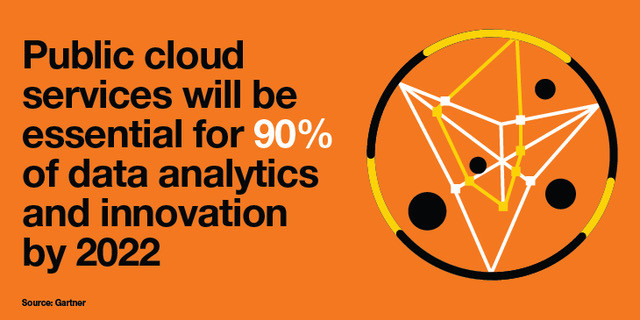Data and analytics, combined with artificial intelligence (AI), are already increasing productivity and driving new business models. Going forward, they will help companies predict, prepare and respond rapidly to any future global crisis and the aftermath, according to Gartner.
However, even in solving traditional challenges such as governance, data privacy, accessibility and data quality, many companies still find it difficult to harvest the business outcomes they expected and even significantly overspend.
One of the principal reasons for this is that the business transformation to a data-driven model often involves a new vision, new mindset, executive sponsorship and a certain way of organizing your talent. It requires new perspectives on building and bringing value to end users, and could even demand you reinvent how you operate as a company.
Missing a trick
Data intelligence is becoming increasingly important in digital transformation for smart and automated decision making. However, many organizations are finding it hard to progress their data intelligence plans. In fact, Gartner maintains that through 2022, only 20% of analytic insights will deliver business outcomes.
Gartner estimates that approximately 60% of big data projects fail, many believe it is nearer 85%. This figure is so high because enterprises treat big data initiatives like traditional IT projects. Data projects, however, are nothing like upgrading firewalls or adopting new development codes. Data is flexible and fluid and means different things to different departments. To reiterate, it requires a cross-functional team and top executive sponsorship to not only move the project forward, but also to pave the way for what could be fundamental changes in the operative model and challenge existing corporate governance and structures.
As well as data scientists, a data project team needs to include business and operational experts, developers and legal, who all have a stake in how and why data is used. This transformation must also have the full attention of business leaders, if data driven is going to become part of an organization’s DNA.
Cloud is non-negotiable
Cloud is now firmly established as being central to any data intelligence program. In fact, Gartner predicts that public cloud services will be essential for 90% of data analytics and innovation by 2022.
Data and analytics leaders, however, are also finding it difficult to align their cloud services to the right use cases, according to the analyst firm. This leads to excessive governance and internal conflicts, which can stifle innovation and lead to unnecessary integration costs.
Gartner suggests that data and analytics leaders need to carefully prioritize workloads, so they can exploit the capabilities of cloud and make cost optimization a focal point when migrating to the cloud.

At the same time, it is important that organizations don’t lock down their data in silos, if they are to exploit the potential of AI on building new revenue streams and data-driven business models. The data needs to flow freely throughout the organizations. If enterprises start to aggressively define what data can be accessed, they limit the scope of AI and its usefulness to business on a strategic and a tactical level.
With the current genre of cloud, built around anything bought as a service, enterprises can reinvent themselves and absorb change faster. AI-as-a-service (AIaaS) is gaining momentum, allowing enterprises to leverage data for meaningful insight, providing the best business support ever, with the help of the right integration partners. In the cloud-native world, we will go a step further than AI-driven services, with business solutions capable of running autonomously.
From data to insights
Some organizations take what they have in their data warehouses and move it to the cloud. When they come to us for help, they are dismayed that they are getting only minimal extra benefits and that the cost of migration does not match the business outcomes that they had expected. This is because they often haven’t taken the time to fully understand the different flavors of the cloud nor how to build and maintain the mindset a data-driven model requires.
Organizations should be able to reap a number of benefits from their data, including increased efficiencies and insight, if they integrate and codify it properly in the cloud and are using a data-driven business model – one that blends data, AI and wisdom together with a new-style governance and ties into the overall business strategy, has shared IT/business ownership and focuses on the use of data for generating information value, predictive analytics, continuous improvement and effective decision making.
This does not come without its challenges, however. According to a recent report by IDC, cloud in particular is proving a major challenge for 62% of chief data officer (CDO) respondents. Key areas of concern include quality, governance and privacy as part of a cloud data warehouse and cloud data lake deployments, mapping transforming and cleansing master data, and ensuring privacy protection across multicloud environments.
Changing the way businesses compete
Data is changing the way businesses compete. Data is now a critical business asset. Selecting the right cloud services and integrating them in a sustainable way to match business requirements is key to getting the data to work for you.
Moving forward, a cloud deployment model built around cloud-native methodologies will enable organizations to better utilize their data, satisfying customers’ needs faster through greater agility and scalability and predictive capabilities.
Find out how this transport company transformed customer experience by adopting a data-driven model.

As a Chief Evangelist, Jan Aril focuses on sharing transparent and inspiring knowledge about his areas of expertise, such as public cloud, big data and AI, with the aim of helping companies take on a more sustainable innovation journey. He has more than two decades of experience in the IT-industry and has held positions from full stack development and sysadmin to C-level and board member. He works across the brands of Basefarm and Orange Business.